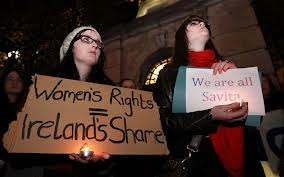Savita Halappanavar’s Bell Tolls for All Women
By Maria Faini and Kim Tran
 Thirty-one year old Savita Halappanavar died in late October from a miscarriage. News of her death haunts women around the world, providing a valuable lesson in the way arguments for religious “freedom” often contradict the necessity of reproductive health.
Thirty-one year old Savita Halappanavar died in late October from a miscarriage. News of her death haunts women around the world, providing a valuable lesson in the way arguments for religious “freedom” often contradict the necessity of reproductive health.
According to her husband, Praveen, Halappanavar went to the hospital a week prior to her death complaining of severe back pain. Her doctors told her she was having a miscarriage but, when she requested that her pregnancy be terminated, they refused, claiming they could still detect a fetal heartbeat. They added that Ireland “is a Catholic country.” Halappanavar and her husband returned home. Her pain continued for days. She died a short time later.
As a country that remains under strong Roman Catholic influence, Ireland is known for having some of the strictest abortion laws of any nation in the world. Although abortion in Ireland has been constitutionally illegal since British rule in 1861, a 1992 Supreme Court ruling exempted cases in which “a real and substantial risk” threatens the woman’s life. Halappanavar’s death is, in part, a result of the ruling’s failure to outline clearly what constitutes such a risk, leaving decisions to medical professionals on a case-by-case basis. Since Halappanavar’s death, more than ten-thousand protesters have filled the streets of Dublin to demand reform to Ireland’s abortion laws.
Such legal ambiguities and their consequences illustrate the ways religion-based laws regulating women’s reproduction fuel social disregard for women’s health. Religious freedom is thus at odds with women’s health, to the detriment of families in many places.
 Though Halappanavar’s doctors were able to abort the fetus legally, they refused to do so on the basis of moral grounds. Arguments for similar religious liberties appear in U.S. political discourse as well. Conservative push-back against women’s health care intensified in the wake of the January 2012 passage of the Affordable Care Act, or “Obamacare.” Under the new law, most health insurance plans would cover contraceptive care for women (including birth control, sterilization, and the morning-after pill) free of charge.
Though Halappanavar’s doctors were able to abort the fetus legally, they refused to do so on the basis of moral grounds. Arguments for similar religious liberties appear in U.S. political discourse as well. Conservative push-back against women’s health care intensified in the wake of the January 2012 passage of the Affordable Care Act, or “Obamacare.” Under the new law, most health insurance plans would cover contraceptive care for women (including birth control, sterilization, and the morning-after pill) free of charge.
One of the most recent examples of such resistance is popular junior Republican Senator Marco Rubio’s “Religious Freedom Restoration Act of 2012.” Rubio’s bill works to absolve any individual or entity from the responsibility “to offer, provide, or purchase coverage for a contraceptive or sterilization service, or related education or counseling, to which that individual or entity is opposed on the basis of religious belief.” Similar political moves have also occurred at the state level. March 2012 saw the passage of legislation to the same effect in Arizona. And, perhaps most egregiously, Mississippi may very well become the first state in the country without an abortion clinic. These restrictions on what the Obama Administration calls “preventative care” are curiously formulated as in compliance with religious freedom.
And yet, in light of such anti-abortion efforts, rates of religiosity in the United States are declining. Only 60 percent of Americans identify as religious, compared to 73 percent in 2005. Further, the rate of atheism rose 4 percent in the same time period. Despite these statistics, demands for religious “freedom” to deny care to women continue, and women and their children remain vulnerable to dismissive medical practices.
It would be easy to analogize Halappanavar’s death with the excommunication of Sister Margaret McBride, who was part of a team of clinicians that approved a life-saving abortion at a Catholic hospital in Arizona two years ago. The Catholic Church only allows for the termination of a pregnancy as a secondary effect of medical treatments; McBride’s quick excommunication was unsurprising. Her expulsion depicts the lengths to which the Catholic Church will go to uphold ideology at the cost of a woman’s life, let alone her choice to determine its course. Both cases demonstrate that eliminating women’s choices is the most destructive way of handling the abortion question. In these instances, we must ask ourselves: Who benefits from “religious freedom”?
Certainly women seeking adequate and accessible health care, and the children who rely on their mothers’ well-being, do not stand to benefit. Women and their children are far better served by programs that advance their quality of life; the best way to ensure a child’s well-being is to do everything possible to enhance the well-being of its primary caregiver who, in most cases, is the child’s mother. To keep women and their families healthy, we must have adequate health care which includes complete access to contraceptive care, access that cannot be fettered by religious beliefs. But the issue is not about health alone. According to The State of the World Population Report published recently by the United Nations, “voluntary family planning” is also a human right, irrespective of religious affiliation.
 Finally, abortion laws pit women against children, born or unborn. Existing policies clearly demonstrate that children are valued more than their mothers. Instead, mothers and children must be understood as interconnected–integral to one another’s well-being. And a mother’s health and happiness could be understood as essential for the happiness of those who love her. If we see a woman and unborn child, and women and men and their growing children, as interconnected, what price do such families pay for a religious freedom that seeks to limit women’s health care? Many religious leaders must examine such freedom’s material effects. All religions need freedom from state control, but not freedom to control people otherwise protected under state law. Halappanavar’s case makes clear, yet again, that conservative anti-abortion movements and their political pursuits too often hurt the families their religious freedom purports to protect.
Finally, abortion laws pit women against children, born or unborn. Existing policies clearly demonstrate that children are valued more than their mothers. Instead, mothers and children must be understood as interconnected–integral to one another’s well-being. And a mother’s health and happiness could be understood as essential for the happiness of those who love her. If we see a woman and unborn child, and women and men and their growing children, as interconnected, what price do such families pay for a religious freedom that seeks to limit women’s health care? Many religious leaders must examine such freedom’s material effects. All religions need freedom from state control, but not freedom to control people otherwise protected under state law. Halappanavar’s case makes clear, yet again, that conservative anti-abortion movements and their political pursuits too often hurt the families their religious freedom purports to protect.
_________________________________________________
About the Authors
 Maria Faini is a PhD student and instructor at the University of California, Berkeley.
Maria Faini is a PhD student and instructor at the University of California, Berkeley.
Kim Tran is a graduate student in the Ethnic Studies program at the University of California, Berkeley. Her work examines refugee communities, transnational labor, gender and queer studies. She is originally from San Jose, California, a proud survivor of California’s public schools and universities who aspires to think alongside young people in classrooms and community.
Her work can be found at www.kimtranpoetry.com






0 comments